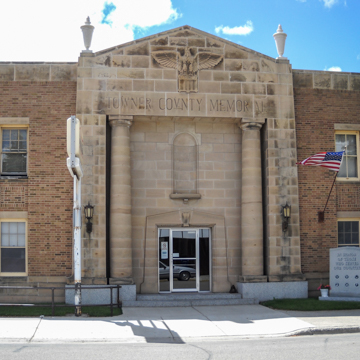Planning for this memorial to soldiers of World War I began in 1921. It is one of several county war memorial buildings in the state dedicated to veterans and casualties of that war. The building served as home to the American Legion, a patriotic organization formed at the end of World War I, and a large auditorium accommodated basketball, boxing, dances, and civic gatherings. The distyle in antis entrance is flanked by an entrance surround that is slightly battered, giving it an Egyptian touch. A somewhat stiff federal eagle—its stylized form adds to the Egyptian flavor—carved into the limestone pedimented parapet commemorates the building’s patriotic purpose. Small-paned windows grouped vertically are separated by a brick spandrel. The interior lobby makes extensive use of stone trim and has an elaborate metal staircase.
You are here
Towner County War Memorial Hall
If SAH Archipedia has been useful to you, please consider supporting it.
SAH Archipedia tells the story of the United States through its buildings, landscapes, and cities. This freely available resource empowers the public with authoritative knowledge that deepens their understanding and appreciation of the built environment. But the Society of Architectural Historians, which created SAH Archipedia with University of Virginia Press, needs your support to maintain the high-caliber research, writing, photography, cartography, editing, design, and programming that make SAH Archipedia a trusted online resource available to all who value the history of place, heritage tourism, and learning.















